The relationship between cause and context
By Unai Etxebarria

Oil on Canvas. 70×100 cm.
Unai Etxebarria © All rights reserved.
“My works of art are a form of reflection addressing processes and social phenomena such as power, control, or exclusion. I cannot escape the events around me. They generally work with a critical intention that requires the commitment of the spectator.”
-Unai Etxebarria
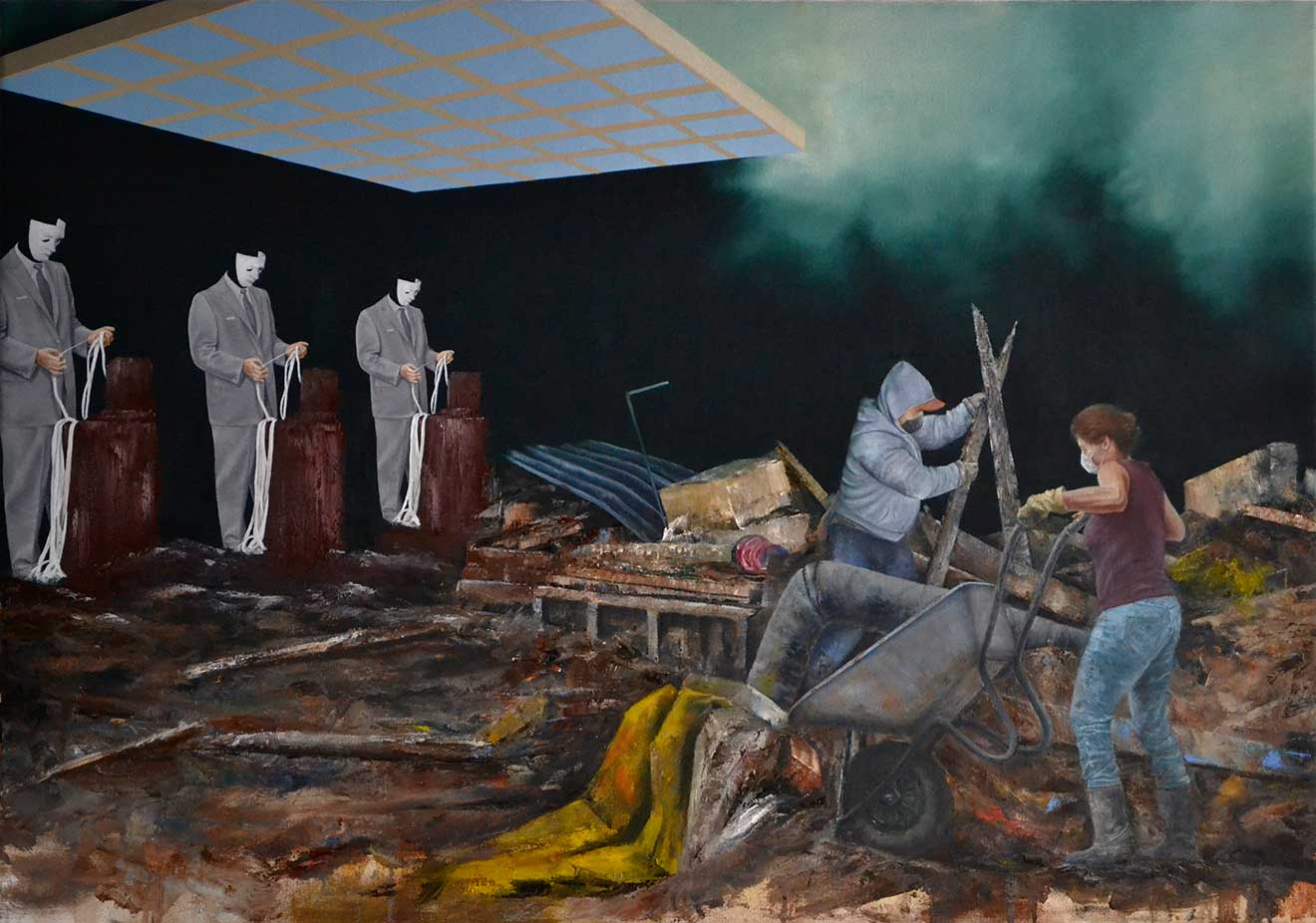
Oil on Canvas. 70 x 100 cm.
Unai Etxebarria © All rights reserved.
“My works of art are a form of reflection addressing processes and social phenomena such as power, control, or exclusion. They have a socio-political dimension, but it is not militant art. I am experiencing a particular cultural, political, and social moment and some of my works reflect this topicality. I cannot escape the events around me. They generally work with a critical intention that requires the commitment of the spectator.
It is the spectator who, with his or her cultural background, experience, knowledge, sensibility, interests, etc., has to reflect on what he or she sees and redefine their own answers to the questions posed by the work. Therefore, they do not narrate at all; they evoke associations and return questions.
The ambiguity remains embedded in the statement of the image, and therefore, the narrative is more likely to be found in the viewer. The basic structure in my paintings is also an interplay of opposites: past and present, beauty and misery, still life and narrative, object and subject, etc.
This interplay of opposites contributes to the ambiguity of the image as it distorts the relationship between cause and context. This invites the viewer to reflect on the relationship between the subject and the content. Indeed, I really like to play with contradictions and contrasts.”
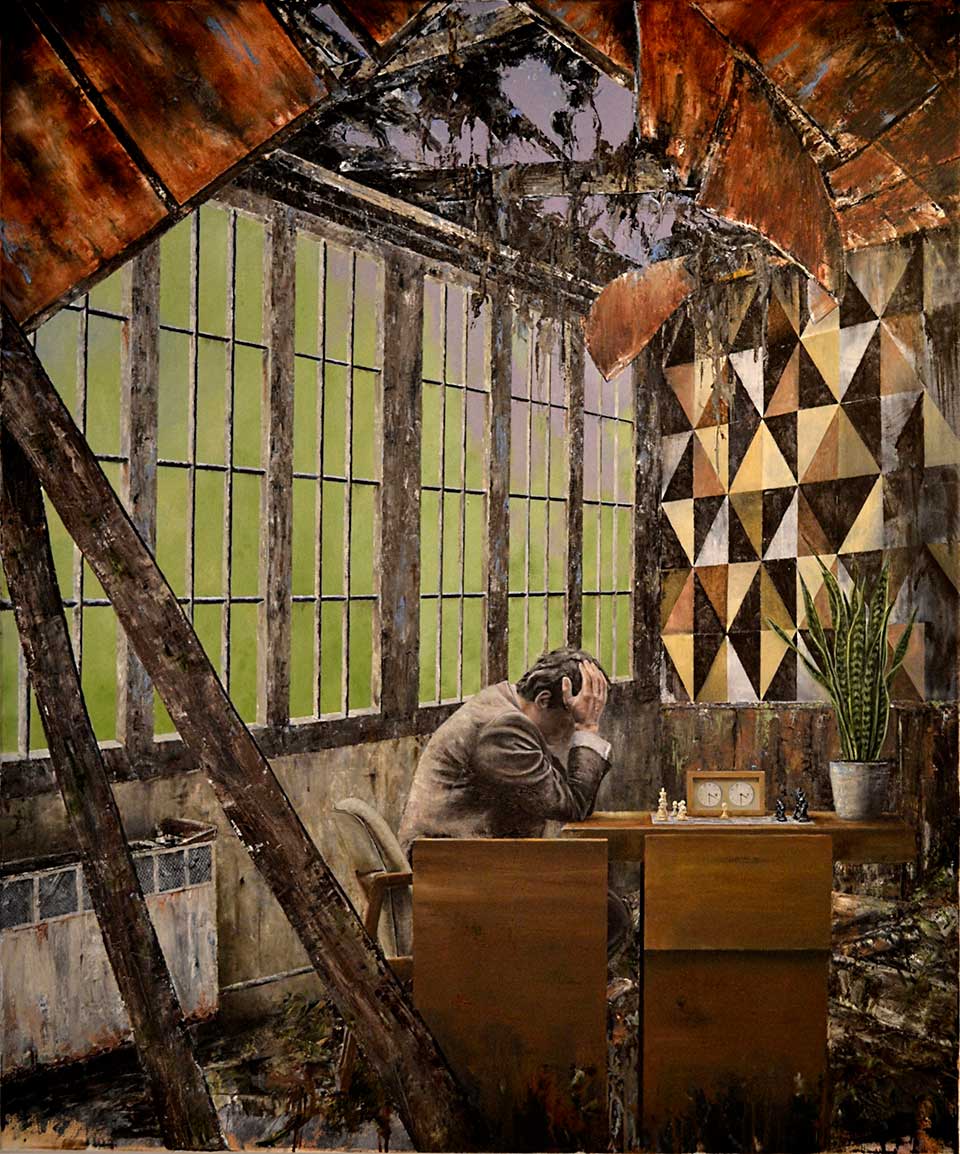
Oil on Canvas. 120 x 100 cm.
Unai Etxebarria © All rights reserved.
“To unify and harmonize them is always one of my goals in painting. Sometimes I succeed; sometimes, hopefully.
Using references from art history is also a constant in my works. References to art history have a communicative potential that speaks directly to the viewer and creates associations that help to enrich the meaning of the work.
One aspect that has changed over time within my works is the humorous and ironic content. Whereas earlier works contained more irony and humor and, at times, purely playful elements, the ironic note is not so evident in my latest works. At most, there are hints of more biting humor. But perhaps this is only temporary.
Maintaining a balance between humor and criticism in a painting is difficult. Too much, in one or another direction, can turn the work into a mere joke or a political or propaganda poster, and perhaps some subjects are more exposed to this danger than others. I have nothing against jokes and propaganda posters; on the contrary, I simply believe that a painting is something else. Its structure, aesthetics, and visual rhetoric are articulated differently.
In general, my painting process is very methodical. THE IMAGE IS FULLY DEVELOPED before I start painting on the canvas. There is very little change from the original idea to what later becomes the painting. It is true that at the moment, I give myself more freedom, and during the painting process, I make alterations and allow myself certain changes, mainly in the compositional aspect.”
Unai Etxebarria
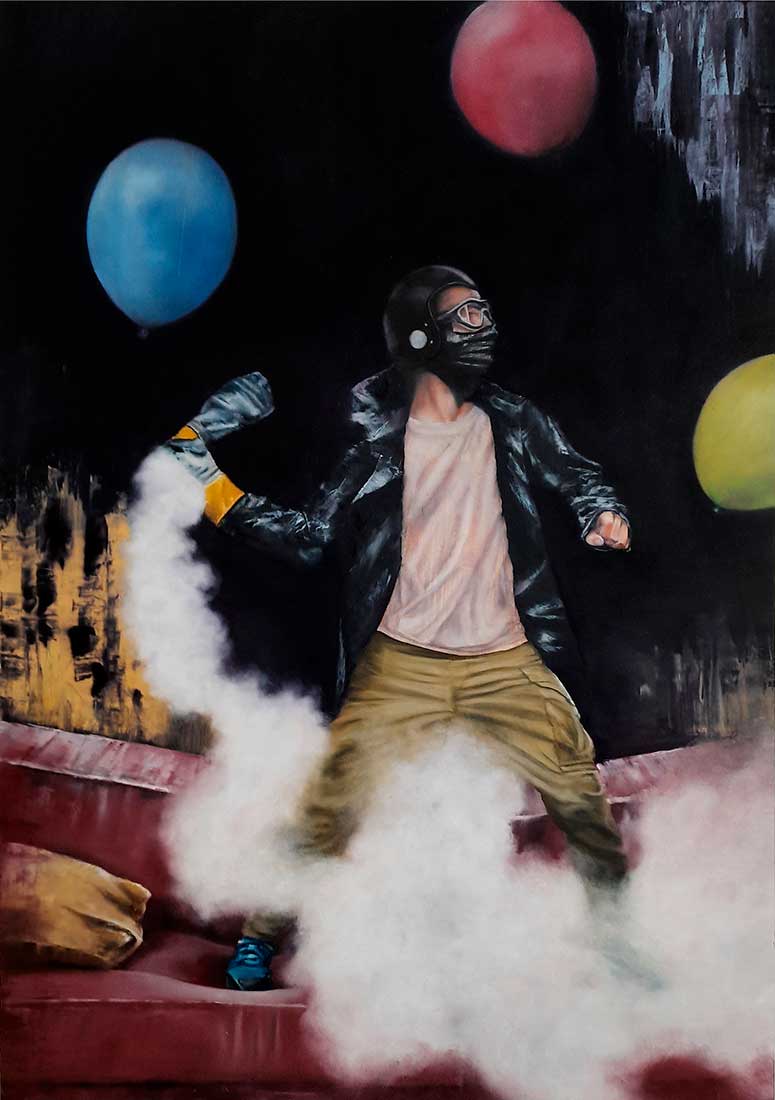
Oil on Board. 100 x 70 cm.
Unai Etxebarria © All rights reserved.
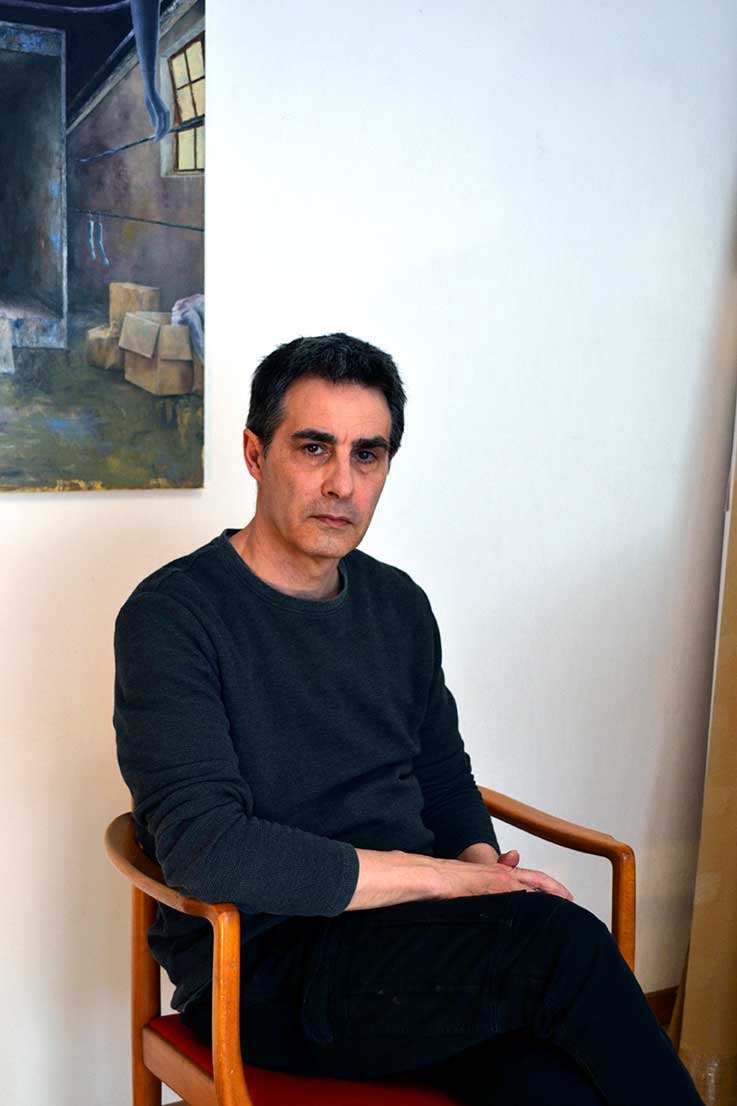
Unai Etxebarria © All rights reserved.
Born in 1968 in Bilbao, Spain, the Basque Country artist Unai Etxebarria paints picturesque sets rich with wit and astuteness that comment on the events of our times. The scenes, in oil on canvas, seem close and palpable – yet they remain mysterious, challenging the viewer to decipher the picture, make assumptions, and work out an interpretation for himself. His pictures are an aesthetic delight and an intellectual adventure.
The dialog that Etxebarria prompts is not only with the viewers of his paintings but also with earlier works from art history. His works repeatedly take up quotations, in a deep bow to the great masterpieces – but with a cheeky wink, too. Delve into his scenes, and you will gain a profound philosophical awareness.
Now based in Germany, Etxebarria had a long journey in his academic studies, focused and graduated in many fields, Philosophy and Theoretical Physics studies, continued by the History of Natural Sciences, where later on, in 1995, he graduated studies in the History of Art, followed by a Ph.D. in Philosophy in 1999.
Etxebarria has exhibited in countless exhibitions and art fairs in the past twenty years, including at Kunstverein Emmerich Gallery, Kuboshow Gallery, Herne, and the latest Discovery Art Fair in Cologne, Germany.

Oil on Canvas. 100 x 80 cm.
Unai Etxebarria © All rights reserved.
Series: Gigantomachy
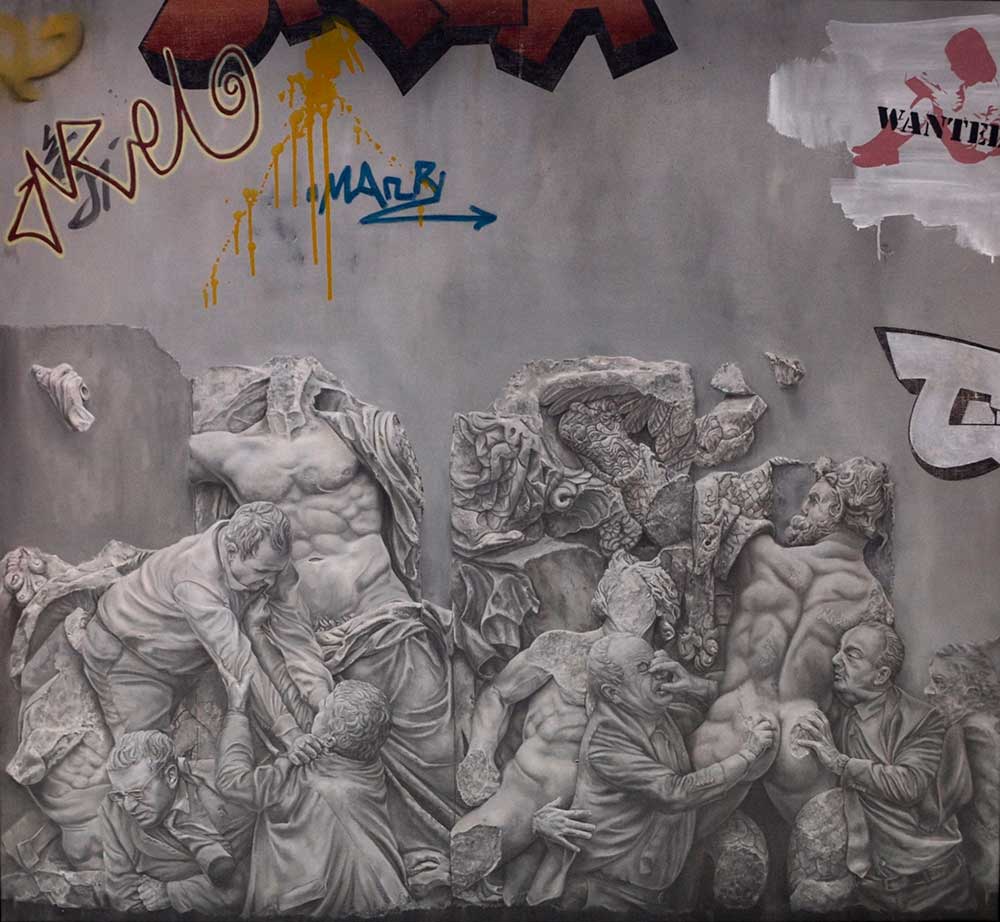
Oil on Canvas. 110 x 120 cm.
Unai Etxebarria © All rights reserved.
In Greek mythology, the Gigantomachy describes the battle of the giants against the Greek gods. The four paintings in the series Gigantomachy refer to different forms and practices of power. The mythological war between gods and giants acts as a metaphorical framework in the paintings, which allows the depiction of different spheres in which the exercise of power takes place.
The ancient sculpture has a communicative potential that I use to address the viewers. The sculpture (or relief) captured in two dimensions evokes something real or symbolic and connects with the other elements of the painting. The sculptural relief organizes the pictorial space and provides the key to the interpretation of the painting. While the antique sculptures embed the depicted scene in a line of continuity with the past, the graffiti and concrete walls evoke the urban space and our present.
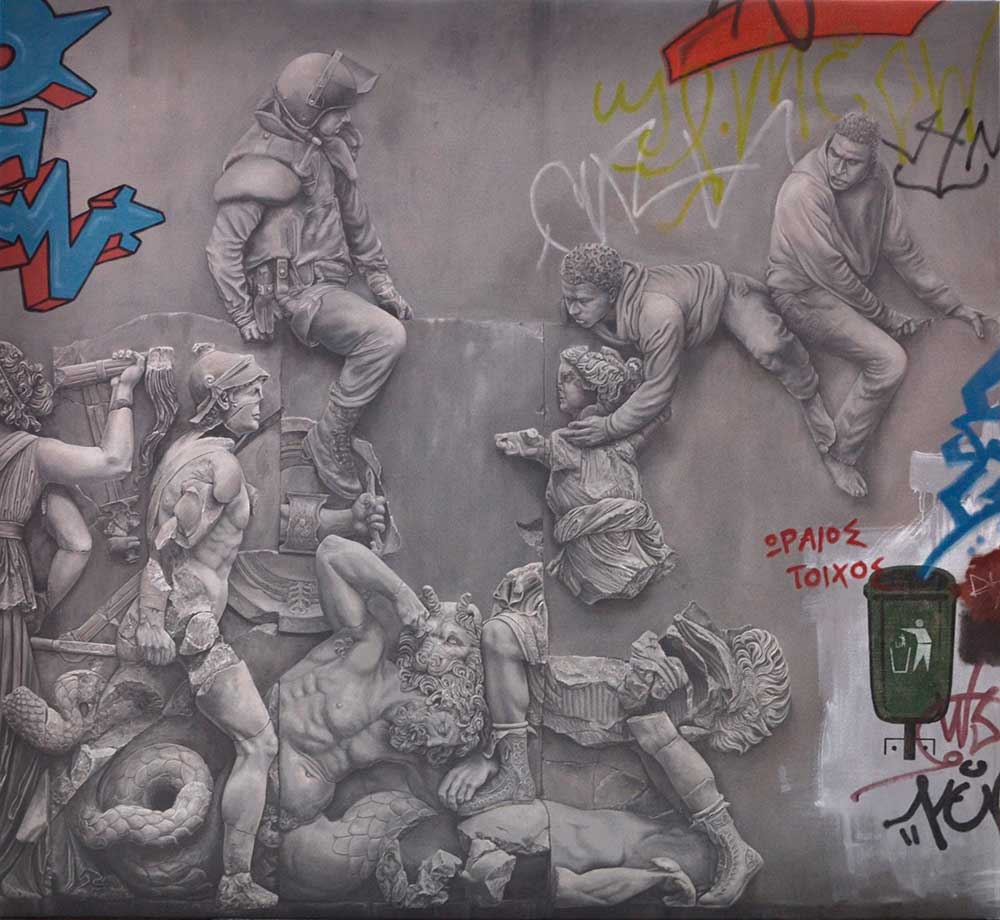

Right: Gigantomachie III. 2018 Oil on Canvas. 110 x 120 cm.
Unai Etxebarria © All rights reserved.
“These four paintings are based on the frieze of the Pergamon Altar, now in Berlin.
As a primary theme, the painting Gigantomachy I shows the preservation of power in politics. Political confrontation understood as the exchange of arguments and persuasion, is depicted here full of irony as an exchange of blows between politicians in the Parliament.
Gigantomachy II painting shows refugee policy as an extended form of territorial power. Borders are sites of power. Walls and barbed wire are the materializations of more complex mental and cultural borders. The image shows two refugees on a wall trying to reach the other side.
The painting Gigantomachy III depicts the theme of the power of money. On the left side of the painting is a scene with stock exchange traders. On the right, a demonstrator is being arrested by the police. A vital aspect emphasized is the contrast of attitudes between aggressiveness and hectic activity on the left versus the relaxed gesture of the arrested demonstrator on the right.

Oil on Canvas. 110 x 120 cm.
Unai Etxebarria © All rights reserved.
The last painting in this cycle, Gigantomachy IV , focuses on the issue of power in gender relations and violence against women. The painting shows an act of violence against a woman lying on the floor.
The only person explicitly portrayed in this series of paintings appears on the left. She is Sampat Pal Devi, a women’s rights activist from India and founder of the self-organization Gulabi Gang. These women wear pink saris and resist male domination and violence in India. India serves here as just one example of a global problem.”

